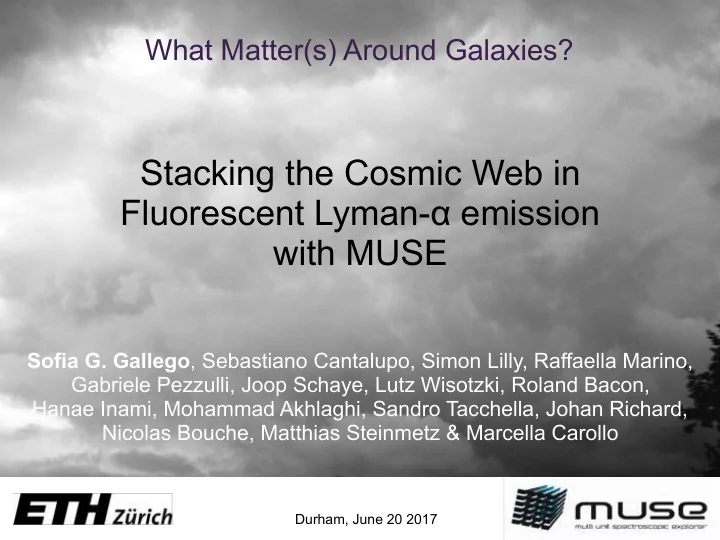

What Matter(s) Around Galaxies? Stacking the Cosmic Web in Fluorescent Lyman- α emission with MUSE Sofia G. Gallego , Sebastiano Cantalupo, Simon Lilly, Raffaella Marino, Gabriele Pezzulli, Joop Schaye, Lutz Wisotzki, Roland Bacon, Hanae Inami, Mohammad Akhlaghi, Sandro Tacchella, Johan Richard, Nicolas Bouche, Matthias Steinmetz & Marcella Carollo Durham, June 20 2017
How can we detect the Cosmic Web? Ly ⍺ z=3 - Cosmological simulations show filaments connecting galaxies - If filaments are LLS their Ly ɑ emission constrains the UVB - Expected SB from UVB fluorescence 1.14x10 -20 erg/s/cm 2 /arcsec 2 (z=3.5) - Current available observations are not deep enough to reach those limits - Oriented stacking along galaxies increase S/N and may show filamentary emission Cantalupo+2012 Durham, June 20 2017
Key Questions Initial WMAG2017 • What is the origin and fate of the CGM? • Are galaxies connected by • What are the morphological and LLS filaments? physical properties of the CGM? • How bright is the UVB? • What are the physical processes that shape the CGM on both large (kpc) and • Is the CGM at kpc scales also small (pc) scales? “oriented” like the • What is the relation between the CGM Cosmic Web? and galaxy properties? • How the questions above • How does the CGM evolve and what depend on can we learn by comparing different galaxy properties? epochs and tracers? Durham, June 20 2017
Stacking Procedure - Lyman alpha emitters (LAEs) selected from the MUSE deep fields (1’x1’) HDFS (89, ~26 hrs) + UDF10 (158, ~29 hrs) - Select pairs of LAEs within 0.5 < cMpc < 20, θ > 16” and 2.9 < z < 4 (195) - Equivalently, select LAEs with a “neighbor” within that range (390) Gallego+17 Durham, June 20 2017
Stacking Procedure - Coordinate Transformation Gallego+17
Let’s look at the filaments!
Results Gallego+17
Results Stack Full Sample Stack - Random Orientations
Results Gallego+17 Durham, June 20 2017
Results SB 2 σ between 6” and 12”: Gallego+17 0.44e-20 cgs SB HM12: ~18x deeper than the cubes! 1.14e-20 cgs Durham, June 20 2017
Results Results Durham, June 20 2017
Results: Split Sample Gallego+17
Discussion • The lack of emission at IGM scales implies: i) UVB is a factor of 3 or more below expectations at z~3.5 (very unlikely), OR ii) IGM filaments are not LLS, OR iii) At least 2/3 of our subcubes do not have LLS filaments (assuming HM12 UVB) • Possible origins for the “statistical excess” CGM emission? •Satellite galaxies •Galaxy fluorescence •Ly ⍺ scattering from the central galaxies Durham, June 20 2017
Discussion • The lack of emission at IGM scales implies: i) UVB is a factor of 3 or more below expectations at z~3.5 (very unlikely), OR ii) IGM filaments are not LLS, OR iii) At least 2/3 of our subcubes do not have LLS filaments (assuming HM12 UVB) • Possible origins for the “statistical excess” CGM emission? •Satellite galaxies •Galaxy fluorescence •Ly ⍺ scattering from the central galaxies Imply higher densities on the direction of the neighbours! Durham, June 20 2017
Key Questions • What are the morphological and physical properties of the CGM? • What are the physical processes that shape the CGM on both Summary large (kpc) and small (pc) scales? • What is the relation between the CGM and galaxy properties? • We perform an oriented stacking of LAEs in the direction of neighbouring galaxies with MUSE • No emission is found on IGM scales (>30 kpc) • Excess of emission is found on CGM scales (<30 kpc), it seems stronger for LAEs with more neighbours and independent of other galaxy properties (luminosity, redshift, distance to neighbours). → Satellites, galaxy fluorescence or Ly ⍺ scattering? Future Directions: • Extend analysis to UDF Mosaic: 1/3 fainter but 3x more LAEs and bigger f.o.v. • Simulations Durham, June 20 2017
Recommend
More recommend